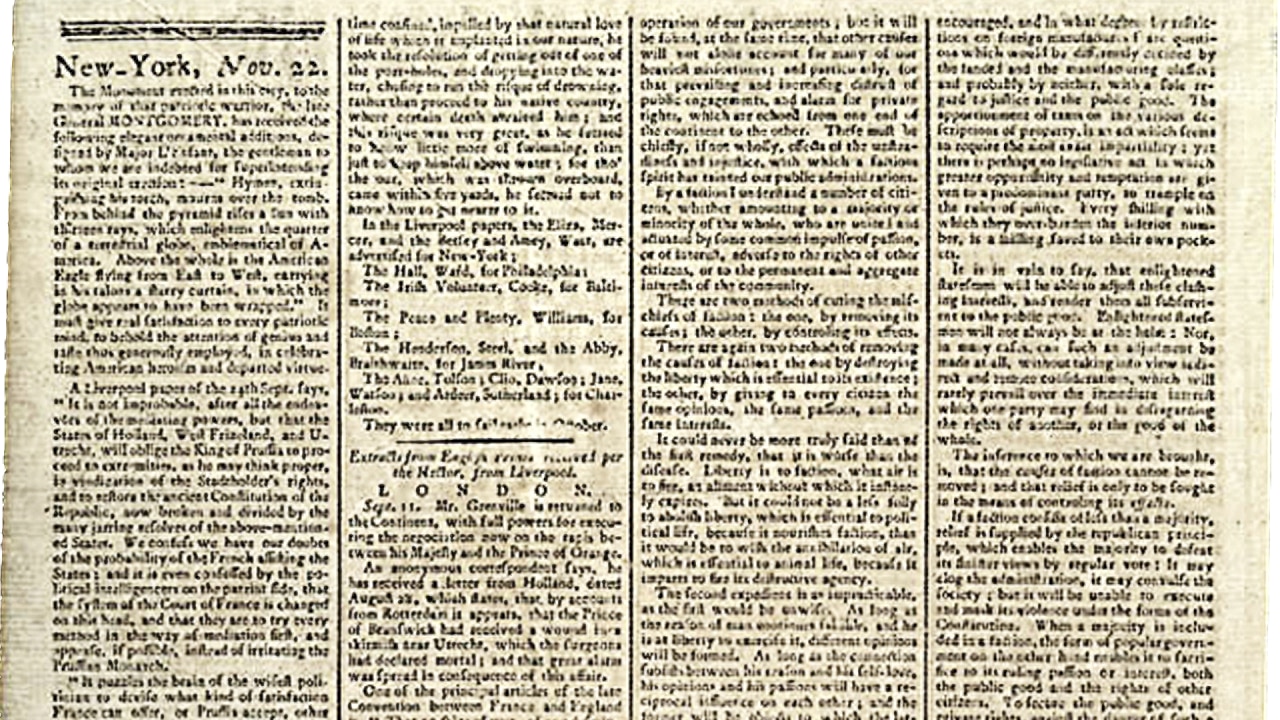When composing the list of books that incoming freshmen should have read before beginning their studies at the University of Virginia, Thomas Jefferson and James Madison included The Federalist Papers. Their list was compiled in 1825, evidence that The Federalist Papers were already considered an authoritative text for understanding and interpreting the Constitution.
While that is undoubtedly so, recently scholars have begun debating whether The Federalist Papers deserve such deference when it comes to defining the principles upon which the American union was founded. Before exploring the opinions on that assertion, here’s a bit of back story on just who were the “Federalists” that wrote those papers, and just what might be a worthy candidate in the campaign to be crowned the most reliable restatement of American political theory.
On September 17, 1787, 39 delegates at the Philadelphia convention signed off on a document creating a new government for the union of the states, but that document was no more than a suggestion until the states voluntarily exercised their sovereignty in deciding to ratify (approve) and be bound by the terms of the newly proposed Constitution.
Beginning in late September, delegates at conventions held in 12 of the 13 states (Rhode Island did not participate) began debating whether to accept the proposed constitution and join a new union with a new government created by the new Constitution, or to reject the proposal and remain independent, sovereign republics.
While it’s pretty well known that the Constitution sent to the states in 1787 is our current Constitution, making it obvious that the states ultimately agreed to accept the Constitution with its newly organized government, there’s a part of the story that is not well known, or, if known, not well understood.
Throughout the months that followed the offering of the new Constitution to the states for their consideration, several varsity-squad Founding Fathers and other renowned patriots did not approve of the proposed Constitution, and they fought vigorously to prevent it being ratified in their home states.
Those men opposing the adoption of the new constitution are known to history as Anti-Federalists. While this term is a misnomer and one never accepted by the opponents of the Constitution, I’ll call them that so as not to create confusion.
On the other side, those men advocating for the ratification by the states of the newly drafted Constitution are known to history as Federalists. Mind you, these federalists have nothing to do with the political party known as Federalists, which was formed after the new Constitution went into effect.
So, why did men like Patrick Henry, George Mason, Samuel Adams, Richard Henry Lee, and James Monroe fight to prevent the proposed Constitution from being adopted by the states?
Generally speaking, their opposition centered around three provisions in the proposed constitution that they believed would eventually lead to the rise of federal tyranny, the erosion of state sovereignty, and the end of individual and civil liberty.
First, the Anti-Federalists believed that the constitution drafted in Philadelphia could be read in such a way as to justify the creation of one consolidated union by, as Patrick Henry said, “swallowing up” the confederation of sovereign states that was created by the Articles of Confederation, the constitution that governed the union throughout the War for Independence.
The second point of contention is related to the first, and that’s that the opponents of the Constitution believed that there was far too much power granted to the federal government in that document, and that the sovereignty and influence of the states and the liberty of the people would be annihilated by a future federal leviathan.
Finally, most of the Anti-Federalists insisted that the proposed Constitution would not protect the rights of the people because there was no Bill of Rights included in that document. They saw a bill of rights as vital to the protection of fundamental liberty and as a critical obstacle between the tyranny of government and the freedom of the people.
Now, with that context established, it is time to return to the issue of which of those two groups has the most compelling claim to be the go-to source for sussing out the intended meaning of the clauses of the U.S. Constitution.
In their article titled “Interpreting Ratification,” posted on July 21, 2023, law professors Andrew Coan and David S. Schwartz asserted:
For two centuries, constitutional interpreters have relied on statements from the ratification debates—especially The Federalist—as persuasive authority in constitutional interpretation. This reliance, which has only increased with the rise of public-meaning originalism, mistakes Federalist campaign literature and oratory for objective and disinterested constitutional interpretation, and mistakenly dismisses the interpretations of Anti-Federalists as irrelevant.
Coan and Schwartz write that when it comes to “the debate over enumerated powers, this article challenges the unfounded assumptions of Federalist objectivity and Anti-Federalist irrelevance.”
The authors’ thesis is that there are historically sound reasons for believing that The Federalist Papers should not be seen as the surest evidence of the definition of provisions and powers intended by the Founders. In support of this, they point to what they call the “insincerity” of some of what James Madison, Alexander Hamilton, and John Jay wrote in their respective contributions to The Federalist Papers.
In fact, they propose that the arguments made by the Anti-Federalists during the ratification debates in the several states are “much more probative evidence of original public meaning [of the provisions in the Constitution] than has generally been recognized.”
At this point, it is important for me to clear up a misunderstanding shared by many Americans. The collection of essays written by Alexander Hamilton, James Madison, and John Jay called The Federalist (more commonly known as The Federalist Papers) was planned, penned, and published according to a blueprint drawn up by Hamilton. The authors used a predetermined pen name (Publius), they selected in advance the issues they would be addressing in their letters, they picked the newspapers in which the letters would be printed, and they followed that plan pretty faithfully.
That’s not true of the Anti-Federalist Papers. You see, there are no Anti-Federalist Papers, and that’s probably one reason for the Anti-Federalists’ failure to prevent the ratification of the Constitution. Many erudite and eloquent patriots wrote letters published in various newspapers encouraging the conventions in their states to reject the new Constitution. The problem was that these able authors didn’t coordinate their efforts and didn’t take on a predetermined slate of issues, and these letters were not collected and published as the Anti-Federalist Papers in the years immediately following ratification. That meant that they couldn’t be easily found, they couldn’t be easily referred to since so few people had access to all the essays, and often the positions taken by the many Anti-Federalist authors were contrary to each other and thus difficult to defend.
It is true that there have been many compilations of the Anti-Federalist Papers published over the past 200 years or so, but you’ll notice that no two of them ever include the exact same collection of essays. However, you’ll find that every edition of The Federalist Papers has the same table of contents listing the same 85 essays.
I contend that had the Anti-Federalists been as well organized, orderly, and focused as the Federalists, there’s a chance we’d still be calling the Articles of Confederation the Constitution.
Finally, there is no need for any American to allow two law professors to tell them whether the Anti-Federalist Papers should receive more attention than they do. Both The Federalist and Anti-Federalist Papers are available online for free and in very affordable paperback editions. Read for yourself and come to your own conclusions about which side’s arguments were more accurate or authoritative. There is no need to drink downstream when you can drink clear water right from the source.
This article was originally published at The New American and is reposted here with permission from the author.




